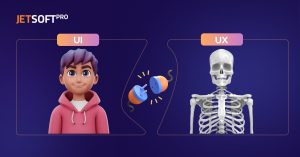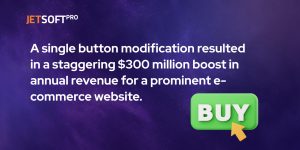In today’s fast-paced and highly competitive landscape of startup software development, achieving success goes beyond simply meeting users’ needs—it requires creating products that captivate, delight, and engage users on a deeper level. This is precisely where the significance of UX/UI design comes into play. In this section, we will delve into the fundamental principles of UX (User Experience) Design and UI (User Interface) Design, uncovering their pivotal roles in shaping exceptional software experiences.
UI/UX’s significance for startups as a game-changing factor becomes apparent when considering the following insightful figures: Forrester Research shows that an exceptional UI can double conversion rates, while an outstanding UX can quadruple them. Additionally, Forrester reports that “Usability” plays a pivotal role, increasing customers’ willingness to pay by 14.4%, reducing brand switching by 15.8%, and boosting product recommendations to friends and family by 16.6%.
Let’s Disclose what UI/UX means
UX Design refers to the process of enhancing user satisfaction by improving the usability, accessibility, and overall interaction between users and a product. It involves understanding users’ behaviors, needs, and goals and then designing products that meet those requirements effectively. The ultimate goal of UX Design is to create a positive and meaningful experience for users.
Key elements and principles:
- User Research: UX Design begins with thorough user research. It involves gathering insights about the target users, their goals, behaviors, and pain points. This research helps in creating user personas and understanding the context in which the product will be used.
- Information Architecture: The information architecture of a product refers to the organization and structure of its content. It involves creating intuitive and logical pathways for users to navigate through the product and find the information they need effortlessly.
- Interaction Design: Interaction Design focuses on designing the way users interact with the product. It involves creating intuitive and user-friendly interfaces, defining user flows, and designing interactive elements such as buttons, menus, and forms.
- Usability Testing: Usability testing involves evaluating the product’s usability by observing users as they interact with it. This helps in identifying usability issues, gathering feedback, and making iterative improvements to enhance the overall user experience.

UI Design, on the other hand, focuses on the visual and interactive elements of a product. It involves designing the look and feel of the user interface, including the visual design, typography, colors, and overall aesthetics. The primary purpose of UI Design is to create visually appealing and engaging interfaces that align with the product’s brand and provide a seamless user experience.
Key elements and principles :
- Visual Hierarchy: UI Design involves creating a visual hierarchy that guides users’ attention and helps them understand the importance and relationship between different elements on the screen. This can be achieved through the use of size, color, contrast, and spacing.
- Consistency: Consistency in UI Design ensures that elements and patterns are repeated throughout the product, providing familiarity and predictability to users. Consistent design elements help users understand the product’s functionality and navigate it more easily.
- Responsiveness: UI Design should take into account various devices and screen sizes. It should adapt and respond to different resolutions and orientations, providing a consistent and optimal experience across platforms.
- Accessibility: UI Design should consider accessibility principles to ensure that the product is usable by a wide range of users, including those with disabilities. This includes designing with proper color contrast, providing alternative text for images, and accommodating assistive technologies.
Understanding the fundamental concepts and principles of UX and UI Design is crucial for startups embarking on software development journeys. By integrating these two disciplines effectively, startups can create products that not only meet users’ needs but also provide exceptional user experiences, driving their success in a competitive market. In the next section, we will delve deeper into the importance of UX/UI design in startup software development.
Who Is a UX Designer?
Imagine a world where every interaction with a digital product is seamless, intuitive, and delightful. That’s the realm where UX (User Experience) designers thrive. These creative professionals are the masterminds behind the overall experience users have when engaging with a product, system, or service.
Drawing on a diverse range of disciplines including psychology, user research, interaction design, information architecture, and visual design, UX designers blend art and science to craft experiences that leave a lasting impression. They collaborate closely with stakeholders, developers, and fellow designers to dive deep into user insights, carve out user personas, and bring concepts to life through wireframes and prototypes. Usability testing and user feedback become their compass as they continuously refine and improve their designs.
At the heart of UX design lies a profound understanding of the user’s journey. Every step, every click, and every interaction is meticulously optimized to ensure the user’s needs, goals, and expectations are not only met but exceeded. From crafting intuitive interfaces to considering factors like ease of use, efficiency, accessibility, and emotional satisfaction, UX designers craft experiences that resonate with users on a profound level.

Ultimately, the true measure of success for a UX designer is creating products that blend functionality with visual allure. It’s about bridging the gap between technology and human needs, resulting in products that not only captivate the eye but also deliver on their promises. By weaving their magic, UX designers transform ordinary digital encounters into extraordinary experiences, leading to satisfied users, loyal customers, and thriving businesses.
7 reasons why investing in UI/UX for Startup is that important
In the early stages of startup software development, resources and time are often limited, and priorities may be focused on building core functionalities. However, neglecting UI/UX design can be detrimental to the success of a startup. Here are several reasons why UI/UX design is crucial for early-stage startup software development:
- User-Centric Approach: UI/UX design places the user at the center of product development. By understanding user needs, behaviors, and pain points, startups can create products that align with user expectations. This user-centric approach ensures that the software addresses real-world problems and provides a satisfying experience.
- Enhancing Usability: UI/UX design focuses on improving usability, making the software intuitive and easy to navigate. A well-designed user interface reduces the learning curve, allowing users to quickly understand and utilize the product’s features. This enhances user satisfaction and encourages adoption.
- Differentiation and Competitive Advantage: In a competitive market, a startup’s success often depends on its ability to stand out. A thoughtfully designed user interface and seamless user experience can differentiate a startup’s software from competitors. By offering an aesthetically pleasing and intuitive product, startups can attract and retain users more effectively.
- Minimizing Development Costs: Investing in UI/UX design early on can save costs in the long run. By identifying usability issues and design flaws at an early stage, startups can make necessary improvements before extensive development takes place. This reduces the need for costly redesigns and rework later in the development process.
- Building User Trust and Loyalty: A well-designed UI/UX instills confidence in users and builds trust in the product and brand. A positive user experience leads to increased user satisfaction and loyalty, which in turn can drive user referrals and positive word-of-mouth. This can be particularly valuable for startups seeking to establish a strong user base.
- Attracting Investors and Partnerships: UI/UX design plays a crucial role in attracting investors and potential partners. An intuitive and visually appealing user interface demonstrates professionalism, attention to detail, and a commitment to providing a quality product. This can make a startup more appealing to investors and increase the likelihood of securing funding or forming partnerships.
- Scalability and Growth: A solid UI/UX design lays the foundation for scalability and future growth. By focusing on user needs and delivering a delightful experience, startups can cultivate a loyal user base and generate positive reviews and referrals. This positive reputation and user satisfaction contribute to the organic growth and scalability of the product.
Investing in UI/UX design early on can save costs, attract investors and partnerships, and pave the way for scalability and growth. By prioritizing UI/UX design, startups can create products that resonate with users, gain a competitive edge, and set themselves up for long-term success.
Challenges and Considerations in UX/UI Design for Startups
One of the primary challenges that startups face in UX/UI design is the constraint of limited resources and time. Startups often operate on tight budgets and have pressing deadlines to bring their product to market. This poses challenges in allocating resources for UX/UI design activities, including user research, prototyping, and usability testing.

To address this challenge, startups can adopt a lean and agile approach to UX/UI design. This involves prioritizing design efforts based on the most critical user needs and focusing on iterative improvements. By leveraging rapid prototyping techniques and involving users early in the design process, startups can make informed design decisions efficiently, maximizing the impact of their limited resources and time.
Startups must strike a delicate balance between design aesthetics and functional requirements. While creating visually appealing and engaging interfaces is crucial for user satisfaction, it should not come at the cost of compromising functionality. Designers need to ensure that the product’s user interface does not overshadow or hinder its core features and functionality.
To overcome this challenge, startups can adopt a user-centered design approach. By understanding the core needs and goals of their target users, startups can prioritize essential functionalities and design interfaces that facilitate seamless and intuitive user interactions. Regular feedback from users and iterative design cycles can help refine the balance between design and functionality.
In the fast-paced world of startups, UX/UI design is an ongoing process that requires continuous improvement. Startups need to embrace an iterative design approach, where design decisions are informed by user feedback and data analytics. This allows for quick iterations and adjustments based on real-world usage and user preferences.
Continuous improvement requires startups to establish a feedback loop with their users. Gathering user feedback through usability testing, surveys, and analytics can provide valuable insights for refining and optimizing the user experience. Regularly analyzing user behavior and engagement metrics can identify pain points and areas for improvement.
Furthermore, startups can leverage user analytics tools and A/B testing to measure the impact of design changes and validate hypotheses. This data-driven approach ensures that design decisions are grounded in evidence and helps prioritize design updates that deliver the most significant value to users.
By embracing iterative design and continuous improvement, startups can create a user-centric culture that fosters innovation and keeps the product aligned with evolving user needs and market trends.
In conclusion, UX/UI design for startups comes with its own set of challenges and considerations. Limited resources and time constraints necessitate a lean and agile approach. Balancing design and functionality requires a user-centered design approach that prioritizes essential features. Iterative design and continuous improvement enable startups to refine the user experience based on user feedback and data. By tackling these challenges head-on and incorporating UX/UI design as a fundamental part of their startup journey, startups can create products that not only meet user needs but also exceed expectations, driving their success in the competitive market.
Best Practices for Incorporating UX/UI Design in Startup Software Development
In the realm of startup software development, incorporating effective UX/UI design practices is crucial for creating products that resonate with users and drive success. By following best practices, startups can ensure that their user interfaces are intuitive, visually appealing, and aligned with user needs. In this section, we will explore some of the key practices that startups should consider when incorporating UX/UI design into their software development process.
- Conducting User Research and Testing
Startups should prioritize user research and testing to gain valuable insights into user behavior, preferences, and pain points. By conducting interviews, surveys, and usability testing, startups can gather data to inform their design decisions. Understanding user needs and goals helps in creating user-centered designs that cater to their expectations. Regularly testing prototypes and collecting user feedback throughout the development process allows for iterative improvements based on real user insights.
- Creating Prototypes and Wireframes
Prototyping and wireframing are essential steps in UX/UI design for startups. Creating low-fidelity prototypes and wireframes early on helps visualize and validate design concepts. These prototypes act as a foundation for gathering feedback and making design iterations before significant development efforts are invested. By using prototyping tools and techniques, startups can quickly iterate and refine their designs based on user feedback, ensuring a more efficient and user-centric development process.
- Collaborating with Designers and Developers
Collaboration between designers and developers is key to successful UX/UI design in startup software development. Designers and developers should work closely together, leveraging each other’s expertise and knowledge. Designers can provide developers with clear design specifications and guidelines, while developers can offer valuable technical insights and feedback to ensure the feasibility and efficiency of design implementation. Regular communication and collaboration throughout the development process help align design and development efforts, leading to a seamless user experience.
- Prioritizing Iterative Design and Feedback Loops
Startups should prioritize iterative design and establish feedback loops to continuously improve their user interfaces. The iterative design process involves creating and refining designs based on user feedback, analytics, and market trends. By launching minimum viable products (MVPs) and gathering user feedback early on, startups can quickly identify areas for improvement and make data-driven design decisions. Regularly reviewing user behavior and analytics allows startups to understand user engagement, identify pain points, and adapt the user experience accordingly.
Feedback loops should be established through user testing, surveys, and analytics tools. Actively seeking user input and incorporating feedback into design iterations ensures that the final product aligns with user expectations and needs.
In conclusion, incorporating best practices for UX/UI design is essential for startup software development. By conducting user research, creating prototypes, fostering collaboration between designers and developers, and prioritizing iterative design with feedback loops, startups can deliver user-centric products that stand out in the market. Embracing these practices allows startups to create intuitive, visually appealing, and engaging user interfaces that drive user satisfaction, adoption, and long-term success.
Case Studies: Successful Startups Emphasizing UX/UI Design
Airbnb: Airbnb revolutionized the travel and accommodation industry by prioritizing user experience and design. The platform’s intuitive and visually appealing interface allows users to easily find, book, and manage accommodations around the world. By focusing on creating a seamless and engaging user experience, Airbnb has attracted millions of users and disrupted the traditional hospitality industry.
Slack: Slack, a popular team collaboration and communication platform, has gained widespread adoption by prioritizing UX/UI design. The platform’s clean and user-friendly interface, coupled with thoughtful features and integrations, has streamlined communication for teams across various industries. Slack’s emphasis on intuitive design and ease of use has contributed to its rapid growth and popularity.
Canva: Canva is a graphic design platform that enables users to create stunning designs without prior design experience. Canva’s success can be attributed to its user-friendly interface, which empowers users to effortlessly create visually appealing graphics, presentations, and social media content. By prioritizing intuitive design and providing a wide range of customizable templates, Canva has become a go-to tool for individuals and businesses alike.
Uber: Uber’s success can be attributed in part to its seamless user experience. The ride-sharing app’s user-friendly interface and simple booking process have transformed the way people hail and travel in urban areas. Uber’s focus on providing a smooth, frictionless experience has driven its rapid expansion and widespread adoption across the globe.
Dropbox: Dropbox, a cloud storage and file-sharing service, has achieved significant success by emphasizing UX/UI design. The platform’s intuitive interface allows users to easily store, organize, and share files across devices. Dropbox’s commitment to user experience has been instrumental in establishing it as a leading player in the cloud storage market.
JetSoftPro’s Success stories of implementing best practices of UI/UX for Startups
JetSoftPro, a leading software development company, has a track record of successfully implementing best practices in UI/UX design for startups. Here are some success stories that showcase our expertise in creating exceptional user experiences:
Augmented Reality App for Furniture: The implementation of a user-friendly UI/UX in this virtual room design application revolutionized the way customers interacted with the product. With a focus on enhancing the online furniture shopping experience, the app provided users with the convenience of creating floor plans, virtually designing rooms, and visualizing furniture and decor options. By leveraging Xamarin.iOS, the app allowed users to design on templates or real room backgrounds, providing them with the freedom to choose furniture from familiar brands and stores. The “Try It Before You Buy It” feature added to the customer experience, enabling users to return or replace furniture if dissatisfied. Additionally, the app included an AR Ruler feature for measuring spaces and ensuring furniture compatibility. By offering a seamless digital platform for settling down, decorating homes, and maintaining comfort, the app transformed the way modern consumers shop for furniture. The user-friendly UI/UX played a vital role in attracting website traffic, increasing brand awareness, and educating potential customers about the convenience of online furniture purchasing. Read more about this case here.
E-commerce Platform: Our client, a startup, introduced an innovative mobile app that seamlessly combined online and brick-and-mortar shopping through geolocation technology. With a focus on UI/UX design, the app provided shoppers with a user-friendly interface to browse nearby stores and enabled quick exchange of requests and offers. The intuitive and consistent UI/UX design facilitated effortless communication through messages, photos, and voice recordings, revolutionizing the shopping experience for both buyers and sellers. Our team delivered a cross-platform app for Android and iOS with responsive design, ensuring a seamless and visually appealing interface. The app’s UI/UX enhancements created an efficient and enjoyable shopping experience, bridging the gap between online and physical stores. Read more about this case here.
AI-powered Fitness App: The successful implementation of UI/UX changes in this fitness app revolutionized the way users interacted with the product. By integrating AI technology and personalization features, the app provided a unique and tailored experience to each user. The user-friendly and intuitive interface made it easy for individuals to navigate the app and access the AI-powered fitness assistant. With the ability to analyze health indicators, metabolism, sleep patterns, and lifestyle, the app delivered personalized fitness programs to help users achieve their goals. Additionally, the app’s synchronization with smartwatches enabled users to track their energy consumption and receive real-time updates on their vital signs. The UI/UX changes played a significant role in enhancing user engagement, ensuring the app’s success in the competitive fitness app market. Read more about this case here.
Travel Booking Application: The implementation of a user-friendly UI/UX in this hospitality industry solution transformed the way guests interacted with hotel providers. With the aim of broadening services and increasing attractiveness to hotel providers, our team developed an interactive web and mobile prototype that turned the best ideas into a practical and understandable reality for users. The solution included a functional website for online booking, ensuring a seamless and centralized experience for guests throughout the selection and reservation process. The intuitive and consistent UI/UX design enhanced user engagement and facilitated one-to-one interaction between guests and hotel providers. Additionally, the responsive mobile application provided convenience and accessibility for users on the go. By delivering a user-friendly interface and a comprehensive solution for accommodations, the product empowered hotel providers to meet the evolving demands and expectations of their guests. The UI/UX improvements played a crucial role in driving customer satisfaction, increasing the value of the client’s services, and establishing a competitive edge in the hotel industry. Read more about this case here.
These success stories highlight our ability to apply best practices in JetSoftPro UI/UX design to deliver outstanding results for startups. By understanding the unique needs of each startup and its target audience, JetSoftPro creates user-centric designs that drive user engagement, satisfaction, and business growth. With their expertise in implementing UI/UX best practices, JetSoftPro continues to empower startups in creating impactful and successful software solutions.
Learn more about JetSoftPro’s expertise in UI/UX Design on our profile on Design Rush.

